Results 4,701 to 4,710 of 12096
Thread: Anandtech News
-
01-28-15, 10:39 AM #4701
Anandtech: Testing USB 3.1: Some Preliminary Results with the MSI X99A Gaming 9 ACK
Everyone wants more. Everyone wants more storage space, faster access, cheaper costs. It should have been here yesterday, but we are restrained at the current rate of development which sometimes moves in strides or sometimes does the 1-2 quickstep. For anyone that owns a desktop, a laptop, or a portable device that needs charging, the USB standard is one such technology that would benefit from being faster, more efficient and less expensive. The USB ecosystem has seen aside several other standards during its tenure, and is now ubiquitous worldwide when it comes to data transfer and charging.
At CES 2015 we saw the first of a new wave of products ushering the latest standard from the USB Implementers Forum, USB-IF, known as USB 3.1. Since the movement to USB 3.0 taking over USB 2.0 in most first world business environments has taken a number of years, other standards such as Thunderbolt are projecting themselves to be a catch-all solution featuring data and display technology throughput with daisy chaining. USB 3.1 attempts to trump this by adding power to the mix, accepting a new type of reversible connector, and integrating itself by virtue of backwards compatibility with all the USB 1.0, USB 2.0 and USB 3.0 devices on the market.
We have covered USB 3.1 in several different articles since the first announcement:
Jan 2014: USB-IF Updates Type C Connector
Jun 2014: USB 3.1 at Computex
Aug 2014: USB Type C Specifications Finalized
Sep 2014: USB Power Delivery v2.0
Sep 2014: Hands On with USB Type C
Sep 2014: DisplayPort Alternate Mode for USB Type-C Announced
Jan 2015: USB 3.1 at CES on MSI Motherboards
The penultimate one is very important, as it indicates that USB Type-C will cover DisplayPort, USB 3.1 data rates and power all within a single specification, more so than Thunderbolt. The last one is one of the reasons for today’s article: MSI is bringing motherboards with USB 3.1 to market. At CES we saw two motherboards using ASMedia’s USB 3.1 controller, one with Type-A due to be released within the month (the X99A Gaming 9 ACK):
And another with Type C, which may be released next quarter (Z97A Gaming 6):
The controller requires two PCIe 2.0 lanes, meaning that the peak throughput for the Type A connectors overall will be 10 Gbps between the two, similar to the way a hub works. At the time of CES, the USB 3.1 speed demonstration hardware was hidden under a box and the press were not able to see into the box in order to get a look. We have worked with MSI to get a hold of this hardware and perform our own testing.
The hardware is an ASMedia testing board with the ASM1352R controller in place, connected to two SSDs. The board places the SSDs in a RAID-0 arrangement, striping the data between them and allowing the Micro-B to Type A to carry the data only. This board is typically used for validation of USB 3.1 data capabilities, rather than anything else. Due to the lack of USB 3.1 hardware on the market, this is ultimately the only way in order to see how far USB 3.1 can stretch its legs.
The X99A Gaming 9 ACK that MSI supplied has several USB arrangements for us to test:Test Setup Processor Intel Core i7-5960X ES
8 Cores, 16 Threads, 3.0 GHz (3.5 GHz Turbo)Motherboards MSI X99A Gaming 9 ACK Cooling Cooler Master Nepton 140XL Power Supply OCZ 1250W Gold ZX Series Memory Corsair DDR4-2133 C15 4x8 GB 1.2V Memory Settings JEDEC @ 2133 Video Cards ASUS R7 240 2GB Hard Drive OCZ Vertex 3 256GB Case Open Test Bed Operating System Windows 8 Build 9600 USB 2/3 Testing ASMedia ASM1352R Testing Board with
2 x Intel 530 240GB SSDs
We are running Kristian’s usual gamut of sequential and random throughput benchmarks while running Windows 8 Build 9600. For USB 3.1, the two Intel 530 240GB SSDs are connected into the ASM1352R testing board. For USB 2.0 and USB 3.0 (both Intel and VIA) we place one of the drives into a Thermaltake BlacX 5G USB 3.0 docking bay and connect it to each of the ports and run the tests.
Also as part of this test, we subjected the drives to the motherboard copy test performed in our motherboard reviews. This involes a copy of 1.52GB across 2867 files, featuring 32 larger video giles and 2800+ smaller web based files. As a result, both short and sequential writes are required to perform well.
The best improvement in results from USB 3.0 PCH to USB 3.1, aside from the peak sequential speeds, is the Random Read/Write performance when paired with the better hardware. Moving from 31.1 MBps on the native Intel USB 3.0 side to 83.9 MBps with ASMedia USB 3.1 is a +170% increase. This allows USB 3.1 to still perform well while under random workloads or when several users/units are requiring bandwidth through a dock at once.
It is worth noting that in terms of CrystalDiskMark, USB-IF has shown faster when Josh was invited during IDF 2014:
It is unclear exactly what system was being used, although Josh mentions it is a pair of SSDs behind a controller. This perhaps shows that the hardware we have at hand is not yet final, or USB-IF has better performing drivers than MSI were able to provide. USB 3.1 is technically good for 1.25 GB/sec, minus overhead due to the 128b/132b encoding (3%) and other functionality (sources state only 7.2 Gbps is useable, limiting peaks to 900 MBps). This would make numbers north of 800 MBps better received than the 650-700 MBps we were able to achieve.
All in all, USB 3.1 from the motherboard controller point of view is working. All we are waiting for is market adoption and the devices to start appearing that can use it. Unfortunately, my predictions lay it on more so for H2 2016 or H1 2017. I say this as a result of time scale adoption on USB 3.0, plus the added issues tied in with Type C connectors.
One of my best markers for gauging adoption rates is actually from trade shows like CES or Computex. I know that USB 2.0/3.0 becomes cheap enough when more of the faster drives is handed out with press kits than the slower drives. For example:
Computex 2011: No USB 3.0, 90% USB 2.0, 10% CD
Computex 2012: 10% USB 3.0, 90% USB 2.0
Computex 2013: 35% USB 3.0, 60% USB 2.0, 5% CD (bad luck, I had my netbook w/o CD drive)
Computex 2014: 60% USB 3.0, 40% USB 2.0
CES 2015: 66% USB 3.0, 34% USB 2.0
The 50/50 crossover happened sometime around Computex 2014. Now one can imagine that manufacturers at trade shows will want to showcase their data as fast as possible, but cost is a part of their showcase at the event. Thus optimistically that crossover point should mark as an indicator for the consumer market. Case in point: USB 3.0 is now only just getting cheap enough to account for the default selection for flash drives here in the UK. I recently purchased a few for install drives as well as a couple for family members. The first module offered to me was a USB 3.0 module, and the price difference between USB 3.0 and USB 2.0 was less than $1 for a 16GB drive.
USB 3.1 will take on the same pattern, if not a little elongated. The first USB 3.0 controllers started appearing on motherboards around the P55 era, circa Q3 2009. So if it takes about 5 years to move from USB 3.0 controllers to 50/50 crossover for the drives, I can only predict that it will take at least the same again, especially when Type C is added into the mix. One potential benefit that USB 3.1 could get is if Intel incorporate USB 3.1 into the chipset from an early stage. Given the fact that one USB 3.1 port needs two PCIe 2.0 lanes, if they are introduced as fixed ports, it will be at the expense of some of the other functionality, unless it can be incorporated into Flex IO.
One other aspect for adoption will be speed. Only the top USB 3.0 drives currently push the limits of the specification, or docking ports that can handle SSDs. So it will be a while before the basic run-of-the-mill flash drives can take advantage as they will have to device a better way to extract performance. But ultimately one of the benefits of USB 3.1 will be for docking, or external hubs that can take advantage of power plus data, especially on the go.
It will be interesting to see where USB 3.1 lands. It makes sense in the desktop space, although Apple is using Thunderbolt so we might have to rely solely on the Windows based notebook manufacturers for this angle. The usual suspects in the storage space will probably roll out USB 3.1 based devices and DAS in late 2015/Q1 2016, with more to follow.
Roll on 2019-2020. I’ll keep my trade show metric in anticipation of 50/50 adoption.
Many thanks to MSI for supplying the hardware for this testing.
More...
-
01-28-15, 11:30 AM #4702
Anandtech: Acer XB280HK 4K G-SYNC Monitor Review
When it comes to gaming, 4K displays present a conundrum (beyond 4K being used incorrectly, but I’ll still use it). On the one hand, all the extra pixels allow for far more detail. On the other, that is a lot of pixels to push for a GPU. Even with the best GPUs out there, you might [Ed: will] have to disable certain features and start to introduce aliasing and other artifacts. A solution to this might be G-SYNC to enable gaming that looks smooth even when running below 60Hz. Read on for our review of Acer's XB280HK.
More...
-
01-28-15, 07:30 PM #4703
Anandtech: Xbox Games With Gold February Preview
February is almost upon us, and with that, we can get a look at the upcoming games for the Xbox Games with Gold program, which provides free games to Xbox Live Gold subscribers. Unfortunately, owners of the Xbox One have pretty consistently only gotten one new game per month, with the previous game generally being made available as well. Hopefully this will change in 2015 as the game inventory for Xbox One continues to grow.
Xbox One
#IDARB
Xbox One owners get the multiplayer game #IDARB, which is a fast paced soccer style game, where players compete either locally or online to score goals in a multi-level environment. It has some issues, such as you can only play online multiplayer with the same number of people you have in the room with you (ie, if you have two local, you can play a 2v2 online game) but it has some insanely fast gameplay, especially with more players. Other Ocean is the development team, which used crowd-sourced ideas to develop #IDARB into the high speed game that it is. The game has a Metascore of 77 right now on Metacritic, and will normally sell for $14.99 on the Xbox store. This game is a new launch title, which is always good to see as the free game for the month.
Xbox 360
Brothers: A Tale Of Two Sons
First up for the Xbox 360 is the puzzle based platformer game Brothers: A Tale of Two Sons, which was developed by Starbreeze Studios. This third-person adventure game has the gamer playing as both brothers, each controlled by one of the analog sticks, and each brother has their own strengths and weaknesses which have to be utilized to move through the levels. It was released on Xbox Live Arcade in August 2013, and won the Best Xbox Game award at the 2013 VGX Awards. Metacritic has this game listed as an 86 Metascore, and 8.6 User Score, so if you have not tried this one out yet, it would be a great one to pick up. Brothers: A Tale of Two Sons It will be available February 1st to February 15th, and normally sells for $14.99 on the store.
“Guide two brothers on an epic fairy tale journey from visionary Swedish film director, Josef Fares and top-tier developer Starbreeze Studios. Control both brothers at once as you experience co-op play in single player mode, like never before. Solve puzzles, explore the varied locations and fight boss battles, controlling one brother with each thumb stick. This is one journey you will never forget.”
Sniper Elite V2
The second game available for the Xbox 360 is the World War II sniper game, Snipre Elite V2. This tactical shooter was developed by Rebellion Oxford, and originally launched in May 2012 on the Xbox 360. This third-person shooter uses stealth and distance, and has a fairly wide open game style where players can finish levels in multiple ways. The Metascore is only 67, and the User Score is only 6.8 on Metacritic, but if you are a fan of this genre, save the $29.99 price and pick it up in February. Sniper Elite V2 will be available February 16th to February 28th.
"ONE BULLET CAN CHANGE HISTORY. BERLIN 1945... V2 Rockets with deadly nerve gas are primed to launch. An army of German and Russian soldiers stand in your way. Make every single bullet count or the world dies with you. X-RAY KILL CAM see organs tear and burst, bones and teeth shatter, as your bullet passes through your enemy ADVANCED SNIPER SIMULATION allow for gravity, wind, distance, breathing and more. SNIPER'S CHOICE leave yourself exposed with the easy shot, or decide a more difficult but stealthier approach. CO-OP MULTIPLAYER battle through 4 war-torn online modes"
Also coming up soon for the Xbox One is some new controller firmware. Currently, powering on the Xbox One controller takes about five seconds for it to boot and connect to the system, but with this new update coming soon, the connect time will be reduced to about two seconds. The controller will also get some stability improvements with this update. Updating the firmware on the controllers means you have to connect them to the Xbox One with a USB cable, and then go to Settings->Devices & Accessories, and then choose Update.
So that is February’s Games with Gold Preview. It is nice to see a new game to the store be made available, but it would be even nicer to see some true next gen games be made available through the program. The gaming industry seems to have given us an abundance of old 8-bit looking games, and the Games with Gold and PlayStation Plus programs have seen their fill of these. Once again, the Xbox 360 lineup looks pretty good though.
Source: Major Nelson Blog
More...
-
01-29-15, 07:00 AM #4704
Anandtech: GIGABYTE GB-BXi7H-5500 Broadwell BRIX Review
Over the last couple of years, the ultra-compact form factor (UCFF) has emerged as one of the bright spots in the troubled PC market. Intel's NUC and GIGABYTE's BRIX are the most popular lineups in this category. Intel's 14nm Broadwell family was introduced into the market with the fanless Core M-based systems. The excellent performance of units based on Core-M has evoked interest in the performance of the upcoming NUC and BRIX units based on Broadwell-U. Intel is taking its time bringing the NUCs to market after officially announcing them at CES 2015. However, GIGABYTE sent over their premium Broadwell BRIX s SKU, the GB-BXi7H-5500, earlier this week. Read on to see what Broadwell-U brings to the UCFF PC market.
More...
-
01-29-15, 07:00 AM #4705
Anandtech: Intel Announces Broadwell vPro Processors: Wireless Docking and More
While Intel formally announced availability of Broadwell-U processors at CES this year, vendors did not actually have any devices available for purchase containing Intel vPro technology. Today that changes, as Intel states the HP Elite x2 1011 and several devices from Fujitsu sporting 5th Generation Intel vPro processors are now available with more to arrive shortly. Businesses that rely on vPro’s management features are now able to purchase new laptops containing Intel’s Broadwell-U processors with vPro features. The main announcement today is of availability, and as such Intel’s press release recaps many of the existing features of Broadwell; rather than cover them one more time, those interested should visit the Broadwell tag for further reading.
If you’re not familiar with vPro, this is primarily an out-of-band management technology that Intel builds into several of their products such as SSDs, NICs, WiFi cards, chipsets, and CPUs. Intel brands their out-of-band management as Intel Active Management Technology (AMT). While many business professionals experience IT management such as software updates and group policy enforcement, these are all at the OS level. Intel AMT provides IT tools at the hardware level, which means remote PCs can be accessed even when the OS is down or the power is off.
For example, if a device is lost containing sensitive data, AMT could be used to access location services of the device, restrict access, or even erase data. Another neat feature of AMT is using an integrated VNC server, allowing remote monitoring of the Intel integrated graphics feed and even keyboard/mouse control. Going even further, Intel AMT can even redirect the boot process of a PC to an IT provided remote image.
New features in Intel Setup and Configuration Software and AMT 10.0 (exclusive to Broadwell) include management of Intel SSD Pro 2500 Series, a location based services editor, Windows InstantGo support, blanking the screen during remote control sessions, and some other low level changes such as patching the OpenSSL heartbeat bug.
Over time, vPro has broadened to include more than just Intel AMT. Importantly, vPro also includes Intel Trusted Execution Technology (TXT), which works with a Trusted Platform Module (TPM) to secure a device against low level attacks and provide unique secure device identifiers to management systems. With Broadwell vPro processors, Intel is again expanding vPro to encompass more technology with Intel Wireless Docking and Intel Pro Wireless Display. It is important to note that these features are available to manufactures using a vPro package from Intel, but each device may not implement them.
Intel Wireless Docking could be the most exciting new feature. Using four channels of 802.11ad at 60 GHz radio frequency, Intel claims a total bandwidth of 7 Gbps. All data passed between the dock and device is protected with 128-bit AES hardware encryption, and two monitors plus USB 3.0 are supported. Intel has not yet provided information yet about supported resolutions, however they do provide an impressive video demonstrating a video file streaming from a USB stick to a laptop from the wireless dock, then back to the wireless dock for display.
This docking implementation is particularly interesting as it is implemented at the chipset level instead of the OS level. Intel’s low level control of peripherals allows them to enable no-brainer functionality such as closing the laptop lid and not entering sleep mode after establishing the dock connection. This saves battery as the laptop display is off, but to date this same functionality has required temporarily changing Windows settings. Additionally, Intel Wireless Docking will connect and disconnect from the wireless dock even if the device is open, closed, or in sleep mode. Anyone who has played the order-of-operations dance with a dock before will surely appreciate this.
One important note about Intel Wireless Docking is that while it uses 802.11ad 60 GHz networking (WiGig), the actual protocol layer Intel runs is different than devices such as the Dell D5000 that also uses 802.11ad; the two are not compatible. Intel stated devices such as the Dell D5000 are typically using 802.11ad as a simple USB bridge using the WiGig Bus Extension (WBE) layer, whereas Intel Wireless Docking is a tight integration with the Broadwell SoC providing new experiences such as those listed above, on-screen-display, and remote firmware management. Intel uses the WiGig Display Extension (WDE) and WiGig Serial Extension (WSE) layers. Intel states they are working with the other Wi-Fi Alliance members through various plug fest and other activities to promote interoperability.
Intel Pro Wireless Display (Pro WiDi) might sound familiar, and this is a variation of the Intel Wireless Display (WiDi) technology with the key naming difference being the insertion of Pro. What does that Pro add other than three letters? Several features aimed at business use cases. Wi-Fi direct connections made by WiDi Pro can now use enterprise security, a display confirmation handshake appears on both screens to prevent accidental sharing to the wrong display, managed display hand off to multiple devices in the same meeting room via GUI operations, and remote IT management of security certificates on Pro WiDi devices.
Finally, Intel Identity Protection Technology (IPT) now supports multi-factor authentication. This provides IT with more options to specify which authentication factors can be used for enterprise applications, such as a paired Bluetooth device.
More...
-
01-29-15, 10:00 AM #4706
Anandtech: Microsoft Releases Finished Versions Of Office For Android
In early 2014, Microsoft released their Word, Excel, and PowerPoint applications for the iPad. Launching their Office suite on platforms other than Windows was something that they had seemed reluctant to do for many years, and so the release of Office on iOS was a pivotal moment for the company. Even more surprising was the fact that iOS received a touch optimized version of Office before Windows did. Unfortunately, users of Android tablets seemed to be left out in the cold, and there was no indication of if or when the applications would make their way over to Google's mobile operating system. But in November 2014, Microsoft released preview versions of their Office applications for Android so they could perform testing and accumulate feedback from users.
Today the Office for Android applications are graduating from their preview status to become complete supported applications that Microsoft feels are ready for widespread use. According to the company, the three applications received a combined 250,000 downloads during the preview period, and were installed on over 3000 different Android device variants. Microsoft's system requirements for the final versions of Office on Android are a device with 1GB of RAM or more, an ARM based SoC, and Android 4.4.x KitKat. Devices between 7" and 10.1" will be able to use the apps for free, while devices larger than 10.1" will require an Office 365 subscription to have access to creation and editing features. Microsoft indicates that the applications are functioning on Android 5.0 Lollipop, but that it is not currently supported. Users of Intel x86 tablets will have to wait for a support update that will be arriving later in the year.
More...
-
01-29-15, 05:30 PM #4707
Anandtech: PlayStation Plus February Games Preview
Sony today announced the upcoming games which will be free for PlayStation Plus subscribers during the month of February. As has become the norm for Sony, there are two games for each platform (PS4, PS3, Vita) and if the game is available on multiple of their platforms, they generally make it available to all of the systems for free. There is a good selection this month, with RPG, platformers, action, and stealth. Let’s take a look at this month’s games.
PlayStation 4
Transistor
The first PS4 game is Transistor, which is a RPG from Supergiant Games, developer of the very popular Bastion game. This game was launched on the PS4 on May 20th, 2014. The name Transistor comes from the name of the main character’s weapon, which is a greatsword that the main character Red comes into possession of at the beginning of the game. This is a well-regarded RPG, and has scored an 83 Metascore, and 8.0 User Score on Metacritic. Transistor normally sells for $19.99 on the PlayStation Store.
“From the creators of Bastion, Transistor is a sci-fi themed action RPG that invites you to wield an extraordinary weapon of unknown origin as you fight through a stunning futuristic city.”
Apotheon
Next up for the Playstation 4 is a new game to the store. Apotheon is from independent game developer Alientrap Games. Set in an ancient Greek mythology, this 2D platform action-rpg has a fantastic looking style. Players are humanity’s last champion, and use the sword, spear, and shield to fight their way through levels. As this is a new game, there are no scores yet on Metacritic, so be sure to check it out when it is available.
“The Gods of Olympus have abandoned humanity, leaving you to perish without their benevolence. Take up arms against the Gods, climb Mount Olympus, and take their divine powers for yourself to ensure mankind’s survival!”
PlayStation 3
Yakuza 4
PlayStation 3 owners will get access to Yakuza 4, which was developed by Sega and released first in Japan and then later in North America in March 2011. It is an action-adventure game where players can continue the Yakuza series, which is set in Tokyo. Yakuza 4 has a 78 Metascore, and 8.0 User Score on Metacritic, and normally sells for $19.99 on the PlayStation Store.
“Yakuza 4 lets you explore the city of Tokyo in an unprecedented level of detail, experience every taboo in the underground world through the eyes of 4 revered men. Can you survive the dangers and temptations of the Japanese underworld?”
Thief
The second game for PS3 owners is Thief, developed by Eidos Montreal and published by Square Enix. Thief was launched in February 2014, and has players controlling master thief Garrett on various missions. This is a stealth based game, where secrecy is rewarded and violence is the last resort. As a big fan of the Thief series on the PC from years back, this was an exciting release which unfortunately did not live up to the hype. Thief has a 70 Metascore, and only a 5.8 User Score on Metacritic. The game normally sells for $39.99 on the store.
“You are Garrett, the Master Thief. Step into the silent shoes of Garrett, a dark and solitary thief with an unrivaled set of skills. The most challenging heists, the most inaccessible loot, the best kept secrets: nothing is out of your reach.”
PlayStation Vita
Rogue Legacy
PS Vita owners will get access to Rogue Legacy, from independent developer Cellar Door Games. Originally released in June 2013, it first game to the PlayStation platform in July 2014. This game features randomly generated dungeons to explore, and has a fairly unique gameplay mechanic where if a character dies, control will switch to a randomly generated heir, and the heirs have unique strengths to bring to the table. Rogue Legacy has an 85 Metascore, and 8.2 User Score on Metacritic, and normally sells for $16.99 on the store. It will also be available on the PS4 and PS3.
“A procedurally generated castle means every run is different. This is a Rogue-lite. Your character dies, but with each passing your lineage grows and becomes stronger. Tons of unique traits make every playthrough special, and with 10 different classes to master, there’s plenty of reason to come back for more (punishment)!”
Kick & Fennick
The second game for the PS Vita is another one that will be released to PS Plus members the same day it goes onto the store. Kick & Fennick is from Jaywalkers Interactive, and is an easygoing platformer featuring a boy named Kick and a robot named Fennick. Kick has in his possession a gun which can be used to shoot down enemies as well as to launch Kick around the level, using the recoil. This is another game with a great artistic style, and it will be available on February 3rd.
“Soon after waking up in a desolate but colorful world, Kick meets a small flying robot named Fennick. When Fennick saves Kick from a menacing guard robot, they find out Fennick’s battery is broken. Together, they embark on an adventure to the Core Tower to find Fennick a new energy core.”
That is the lineup for February. It looks pretty good this month, with a nice mix of genres and game styles. The PlayStation 4 games look quite interesting this month, which is great to see since normally the limited game selection means that the older platforms can have more variety. Now that the console is over a year old, there is a good stable of games available.
Source: PlayStation Blog
More...
-
01-30-15, 02:00 PM #4708
Anandtech: Super Flower & 8Pack Release the World's First 2kW Consumer PSU
A new record was broken today, as Super Flower announced the release of the most powerful consumer PSU ever made, the Leadex Platinum 2000W. The PSU has been allegedly developed with the collaboration of Ian "8Pack" Parry, one of the most reputable overclockers worldwide, and in association with OverclockersUK.
The power specifications of this monster are certainly impressive. It is 80Plus Platinum certified and the single 12V rail that can output up to 166.6A, implying a certain fire hazard if that current were to be drained from a single connector. It also sports a fully modular design, which is a good thing for a PSU with twenty cables. The choice of a simple dual ball bearing 140mm fan is questionable for a product with such a price tag, but it obviously is not primarily designed with low noise operation in mind.
Huge numbers are certainly impressive, but let us also remember that the power requirements of a typical gaming PC hardly are a quarter of what this monster can output. Not even highly advanced multi-GPU systems require such power. Simply put, if you own anything less than an overclocked system with four GPUs, this product has nearly zero practical value. For example, in Ian's dual X5690 system with four AMD 7970 GPUs, he pulled 1550W with some basic overclocks on a 1600W PSU, meaning that a full sub-zero OC system has room to breathe with 2000W at hand.
With computer PSUs, bigger is not necessarily better, as the efficiency of the unit peaks at about 50% of its maximum power rating and declines if the load decreases or increases. Actually, due to their design, the efficiency of most switching PSUs plummets if the load is lower than 20% of the unit's rated capacity. Therefore, buying a very powerful PSU in order to have "better performance" and "headroom" is not always such a good idea, but for those who need it, 2000W could have practical applications.
Source: OverclockersUK
More...
-
01-30-15, 02:30 PM #4709
Anandtech: Google Announces Support For 40 Third-Party App Cards In Google Now
Google Now has always been good at giving you relevant information about things like transit, emails, stocks, sport scores, etc. But everything it displays is linked to a Google product in some way, which means that even with Google's vast accessible information, the scope of what information Google Now can provide is limited.
Today Google has announced an update for the Google application on Android. The update allows Google Now to display cards with relevant information from 40 different third party Android applications. The list of third party apps includes some big names like Lyft, Pandora, and Airbnb, and it's not hard to imagine how the ability to display relevant and actionable info in Google Now could make the experience of using these apps even better. The full list of partnered applications can be found here on the Google Now webpage, and you can see some example cards in the image above.
According to Google, the update to the core Google app on Android is rolling out now, and updates for cards from the developers Google has partnered with will be rolling out over the next few weeks. Google also intends to expand the library of supported third-party applications over time.
More...
-
01-31-15, 10:30 AM #4710
Anandtech: ASUS ROG Announces the B85M-Gamer Motherboard
In recent months it would seem that ASUS’ Republic of Gamers brand has split into some very distinct segments. We used to only have three SKUs to choose from: the Extreme, the Formula and the mATX Gene. Along came the mini-ITX Impact, then the Ranger, and then something called the Pro Gamer.
Today we received a press release regarding the announcement of the B85M-Gamer, which has very little mentioning of ROG at all. Typically ROG is ASUS’ high-end gaming brand, so it would make sense to align something more budget just under the ‘Gamer’ name rather than a full blown ROG. The B85M-Gamer, despite being a business chipset, it going for the cheaper Intel market which already includes non-overclocking products from GIGABYTE and MSI. This market attacks the price/performance segment for home users and gamers along with the system integrators or businesses such as cyber cafés in Asia who want a gaming angle.
The board is mostly black with red accents featuring a four-phase DIGI+ power solution, four SATA 6 Gbps, two SATA 3 Gbps, and a single PCIe 3.0 x16 slot. Audio comes under the ROG SupremeFX banner, meaning an enhanced Realtek ALC1150 solution with PCB separation, additional filter caps, a headphone amplifier for up to 300 ohm headphones and an EMI shield. The Intel NIC is paired with LANGuard for surge protection to defend against lightning strikes, and one would assume that the AI Suite 3 software also caters for some element of networking control. ASUS is reporting that the configuration they have selected has better UDP throughput for gaming than other solutions.
Four USB 3.0 ports and support for 32GB of DRAM is also present. ASUS hope that pairing this board with a Pentium, Core i3 or even an i5, as well as a mid-range graphics card, can provide an effective gaming tool in the B85 market for mATX builds.
As this press release came via ROG rather than ASUS USA, it is hard to tell if it will be stocked in the US or is more focused in Europe/Asia. As a result, no pricing or release date has been attached.
Source: ASUS ROG
Gallery: ASUS ROG Announces the B85M-Gamer Motherboard

More...
Thread Information
Users Browsing this Thread
There are currently 51 users browsing this thread. (0 members and 51 guests)




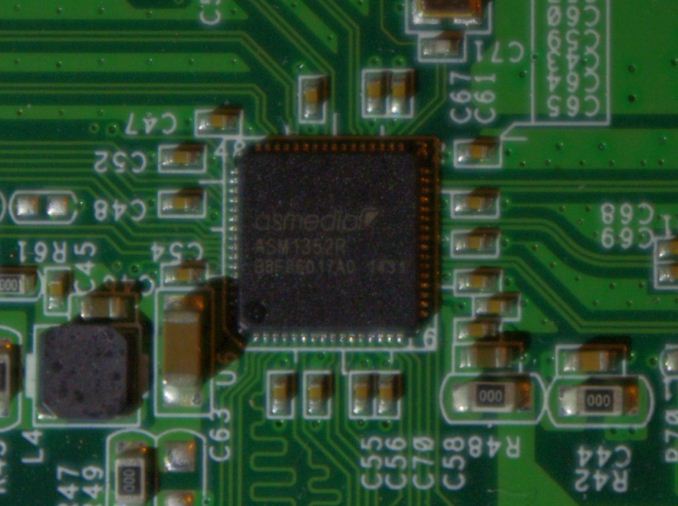
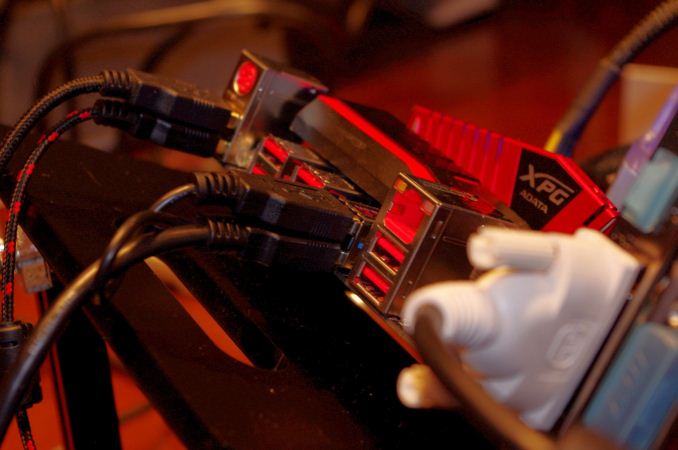
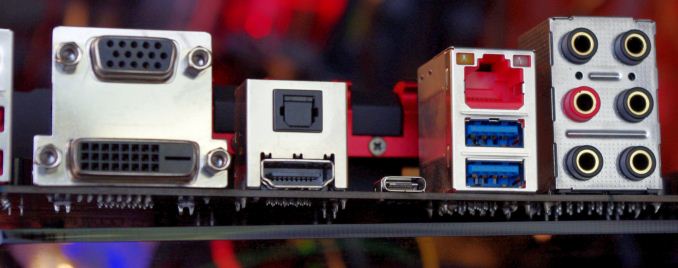
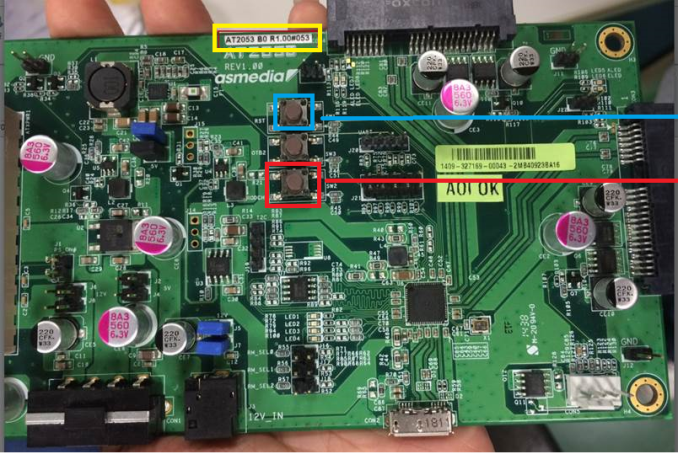
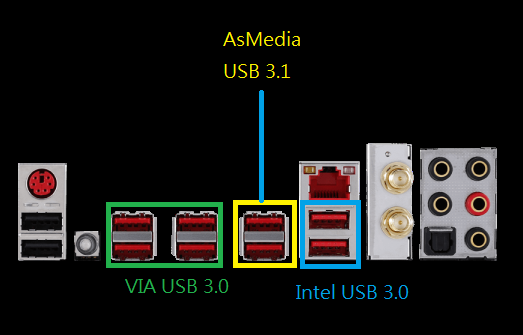












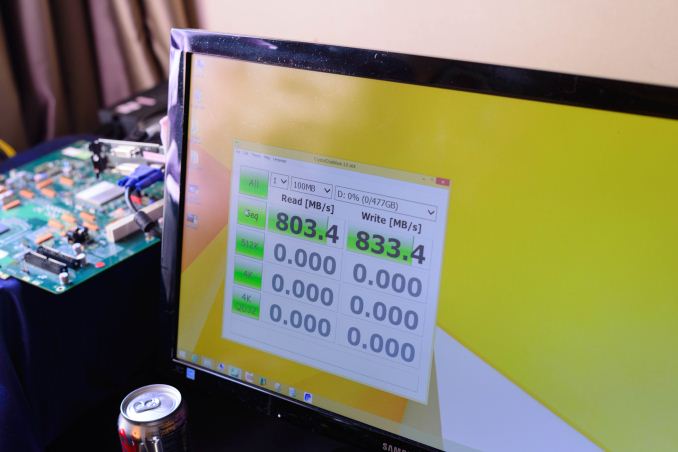

 Quote
Quote



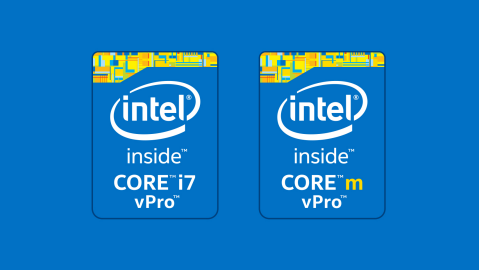
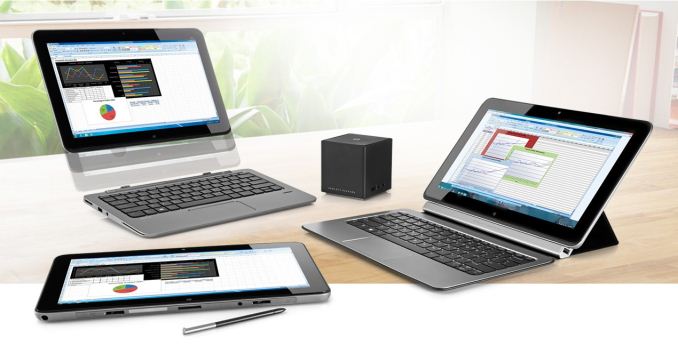
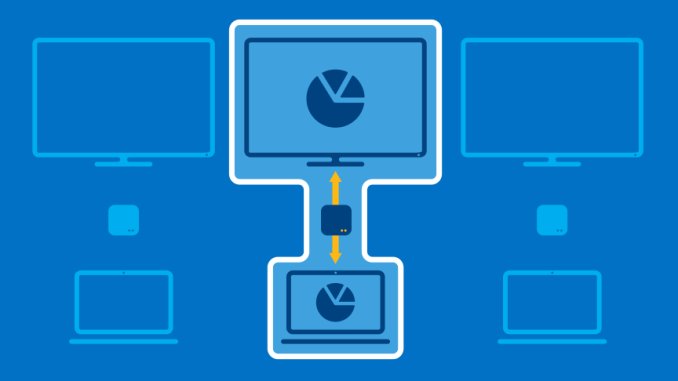
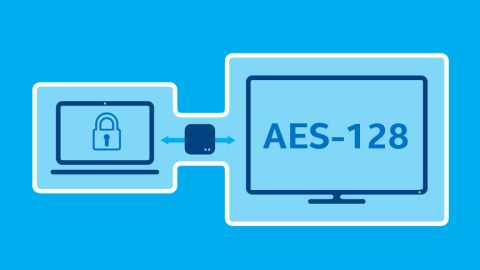

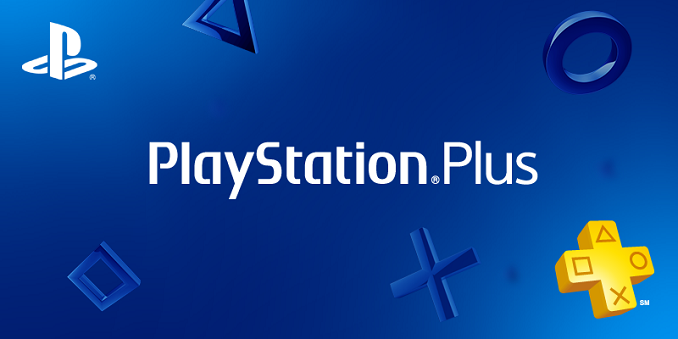







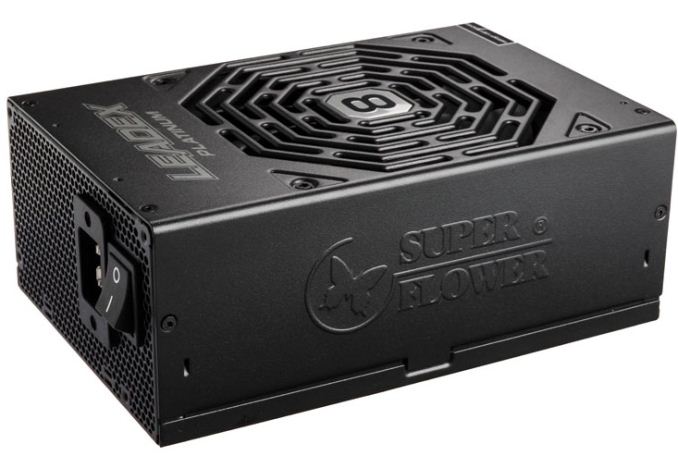
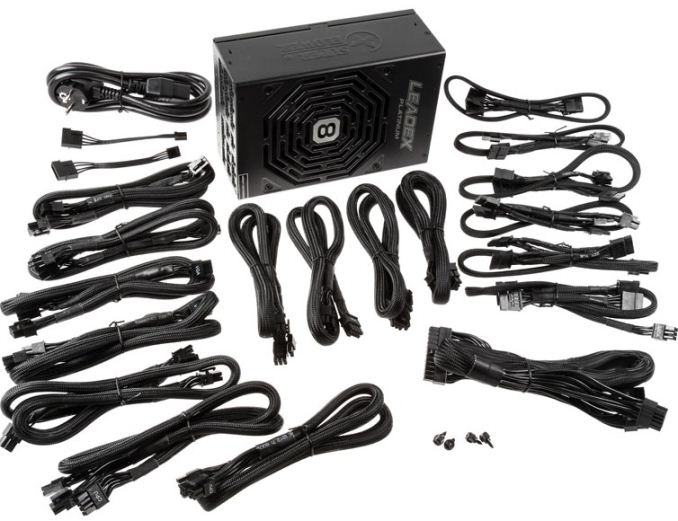

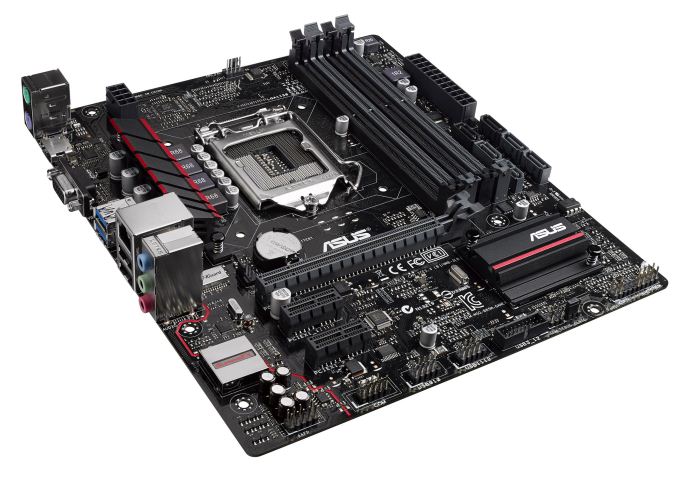
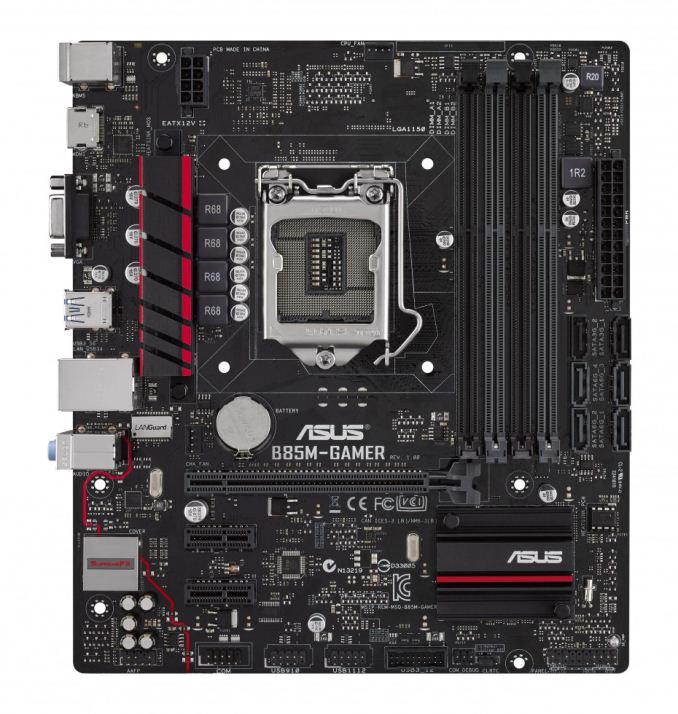
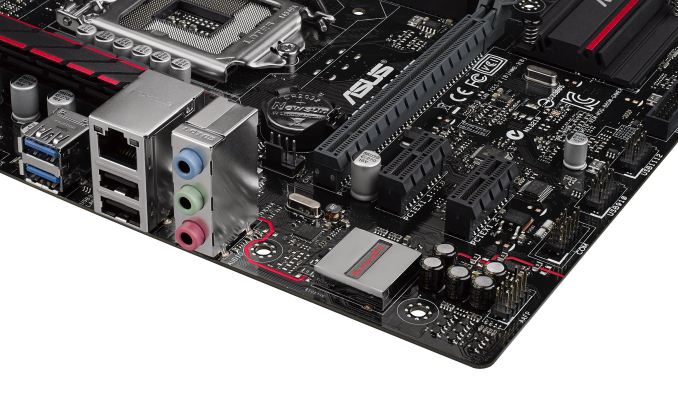
















Bookmarks